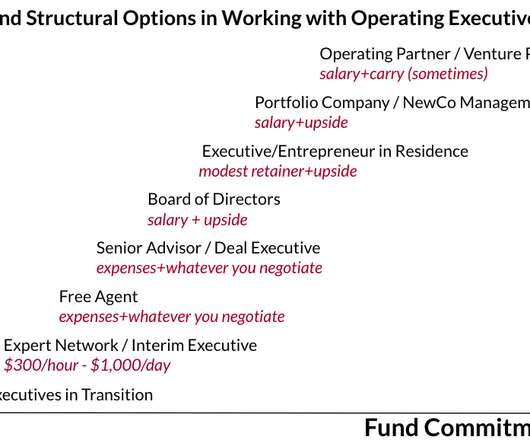The VC Stack Makeover: What Today's Funds Need - Webinar
The Seraf Compass
JULY 21, 2025
For an industry built on innovation, our infrastructure has lagged behind.
This site uses cookies to improve your experience. To help us insure we adhere to various privacy regulations, please select your country/region of residence. If you do not select a country, we will assume you are from the United States. Select your Cookie Settings or view our Privacy Policy and Terms of Use.
Cookies and similar technologies are used on this website for proper function of the website, for tracking performance analytics and for marketing purposes. We and some of our third-party providers may use cookie data for various purposes. Please review the cookie settings below and choose your preference.
Used for the proper function of the website
Used for monitoring website traffic and interactions
Cookies and similar technologies are used on this website for proper function of the website, for tracking performance analytics and for marketing purposes. We and some of our third-party providers may use cookie data for various purposes. Please review the cookie settings below and choose your preference.

The Seraf Compass
JULY 21, 2025
For an industry built on innovation, our infrastructure has lagged behind.

StartupNation
JUNE 4, 2025
This article breaks down the essentials of innovative design techniques that have a proven track record for engaging investors. I’ll never forget presenting to a particularly skeptical VC who kept questioning our projections. I also incorporated a live demo section to enable investors to see the tool in action.
This site is protected by reCAPTCHA and the Google Privacy Policy and Terms of Service apply.

Founder Bounty
MARCH 25, 2025
We have already done the article is antler worth doing here and a lot of you are asking what exactly are the investment terms if they do offer you investment. Follow-On Investment Antler often reserves capital for follow-on rounds and participates in seed and Series A rounds. In some regions, they offer $125,000 for 10% equity (e.g.,

David Teten VC
APRIL 16, 2025
Download here our Template General Partner Entity Agreement for Your New Private Equity or VC Fund. Thanks to my coauthor Dolph M. Hellman, Esq.

Leapfunder
JUNE 5, 2025
VCs in our network: Get started Sign up as investor Sign up as startup Sign up as VC Invest in startups Early Bird Holedo The Netherlands Every industry has a talent pool. Read 43 articles Learn handling investment and funding and utilizing the platform of leapfunder to its full potential. Return p.a. You pay to search.

Leapfunder
JUNE 5, 2025
VCs in our network: Get started Sign up as investor Sign up as startup Sign up as VC Invest in startups Early Bird Holedo The Netherlands Every industry has a talent pool. Read 43 articles Learn handling investment and funding and utilizing the platform of leapfunder to its full potential. Return p.a. You pay to search.

Leapfunder
JUNE 5, 2025
VCs in our network: Get started Sign up as investor Sign up as startup Sign up as VC Invest in startups Early Bird Holedo The Netherlands Every industry has a talent pool. Read 43 articles Learn handling investment and funding and utilizing the platform of leapfunder to its full potential. Return p.a. You pay to search.

Leapfunder
JUNE 5, 2025
VCs in our network: Get started Sign up as investor Sign up as startup Sign up as VC Invest in startups Early Bird Holedo The Netherlands Every industry has a talent pool. Read 43 articles Learn handling investment and funding and utilizing the platform of leapfunder to its full potential. Return p.a. You pay to search.

Leapfunder
JUNE 5, 2025
VCs in our network: Get started Sign up as investor Sign up as startup Sign up as VC Invest in startups Early Bird Holedo The Netherlands Every industry has a talent pool. Read 43 articles Learn handling investment and funding and utilizing the platform of leapfunder to its full potential. Return p.a. You pay to search.

Leapfunder
JUNE 5, 2025
VCs in our network: Get started Sign up as investor Sign up as startup Sign up as VC Invest in startups Early Bird Holedo The Netherlands Every industry has a talent pool. Read 43 articles Learn handling investment and funding and utilizing the platform of leapfunder to its full potential. Return p.a. You pay to search.

Both Sides of the Table
MAY 23, 2012
This article originally ran on PEHub. Many observers of the venture capital industry have questioned whether its best days are behind it. I can’t help feel a bit of rear-view mirror analysis in all of “VC model is broken” bears in our industry. The number of venture capital funds has shrunk by two-thirds.

This is going to be BIG.
JUNE 26, 2012
I always get asked how to get into VC and so I think a lot about what it takes to do the job well. In venture capital, you say "no" a lot. Practicing the word no as many times as a VC does means you have to fight not to have your mind close on you. For some, VC is about the picking rather than the fostering and growing.

Both Sides of the Table
MAY 24, 2021
Of the first four investments I made as a VC in 2009, two have exited and two (Invoca & GumGum) still are independent and likely to produce $billion++ outcomes . The abundance of late-stage capital is good for us all. My first ever investment as a VC was Invoca. The abundance of late-stage capital is good for us all.

This is going to be BIG.
APRIL 14, 2014
Last week, there was a Business Insider article measuring the percent of female founded companies that NYC seed funds invest in. Most companies don''t ever raise venture capital and they do just fine. That''s a much better picture of female entrepreneurship than the 2-4% of venture capital dollars going to women.

Both Sides of the Table
SEPTEMBER 29, 2013
If you track the venture capital industry it would be hard to miss the conversation going on this week over AngelList “Syndicates.” My favorite new VC blogger, Hunter Walk, weighed in with some thoughtful comments about how Syndicates might actually pit, “ angel vs. angel.” Bowery Capital).

This is going to be BIG.
NOVEMBER 15, 2020
Even after Fowler’s article came to the forefront and investors Freada and Mitch Kapor broke ranks with their silent co-investors in their now-famous open letter , things didn’t get better. In late 2018, the company raised $75 million Series C from Sequoia, arguably the top VC firm in the world. VC David Sacks tweeted “??

Both Sides of the Table
MARCH 3, 2013
He spoke about ROCE (return on capital employed). But “on capital employed” encourages companies to push more off balance sheet and thus into offshore & outsourced situations. Venture Capital. We spoke about the disruption of VC through crowd funding. So they could monetize and people would pay.

David Teten VC
SEPTEMBER 13, 2022
It’s hard enough to raise capital from VC, private equity fund, and family offices. The vastly larger universe of B2B companies, many of which have teams focused on pushing VC and private equity funds to evangelize their product to their portfolio. See my list of due diligence questions for VC and private equity funds. .

Both Sides of the Table
SEPTEMBER 27, 2012
This article originally appeared on TechCrunch. Recently I wrote a post arguing to make the definition of a Startup more inclusive than that to which Silicon Valley, fueled by Venture Capital return profiles, would sometimes like to attach to the word. The key it to have “realistic capital.” Otherwise, good luck!

David Teten VC
JUNE 9, 2021
Would you like to work with private equity and venture capital funds? There are relatively few jobs directly inside private equity and venture capital funds, and those jobs are highly competitive. See How to negotiate a partner role at a VC or private equity firm.) At Versatile VC , we’ve used all these models.

This is going to be BIG.
DECEMBER 21, 2017
Nothing seems to apply--you're not a tech company, you bootstrapped your way to millions in revenues before taking on capital, and you sell mostly through brick and mortar. Adam Struck brought on significant additional capital from his network. 3) Find a flexible lead. This led to him actually joining the company as President.

AsiaTechDaily
SEPTEMBER 6, 2023
Register Gyeonggi-do Business and Science Accelerator (CEO Kang Sung-cheon) is holding an online event to match global venture capital firms with innovative startup companies in Pangyo. In addition, GBSA plans to help Korean startups enter the global market by collaborating with global VC firms.

This is going to be BIG.
MARCH 25, 2013
It's even more relevant now that I've started the first venture capital fund in Brooklyn-- Brooklyn Bridge Ventures --and invested in four Brooklyn based companies. The definitive article about 33 Flatbush--the kind of commercial building you would drive by a million times without thinking twice-- was written in the NY Times a few years ago.

TechCrunch
DECEMBER 5, 2021
based Harlem Capital. We’re thrilled to be working with Harlem Capital,” co-founder and CEO Yacob Berhane said of Harlem’s participation. When TechCrunch covered Pariti in March, the company which connects founders in emerging markets to resources, talent and capital, was fresh out of finding product-market-fit.

TechCrunch
SEPTEMBER 12, 2021
But most venture-backed startups are “still overwhelmingly white, male, Ivy-League-educated and based in Silicon Valley,” according to a study conducted by RateMyInvestor and Diversity VC. Or will we have to repeat the same conversations about representation failings within VC funds? Think of the worst-case scenario.

TechCrunch
DECEMBER 24, 2021
This week, Bill Taranto, president of Merck’s Global Health Innovation Fund, wrote a TechCrunch+ article that explored six digital health trends his corporate VC fund is tracking as we enter 2022. billion in VC, “dwarfing the previous record of $14.6 Full TechCrunch+ articles are only available to members.

TechCrunch
JUNE 10, 2022
Building a company is a high-stakes effort, so here’s a promise: I won’t approve articles with advice for navigating this downturn unless the author has direct experience with the matter. Full TechCrunch+ articles are only available to members.

TechCrunch
APRIL 19, 2022
Full TechCrunch+ articles are only available to members. Follow-on investors who take advantage of the closing IPO window to foist unfavorable terms on founders are “the bottom feeders of the venture capital business,” writes Steve Blank. If making as much money as you can is your primary goal, however, prepare to be disappointed.

TechCrunch
DECEMBER 31, 2020
Full Extra Crunch articles are only available to members. The VCs who founders love the most. Shauntel Garvey and Jennifer Carolan, Reach Capital. Using lessons learned from her portfolio companies like Lyft, Refinery29 and Twitch, this article should be required reading for every founder. ” Ian Chiu, Owl Ventures.

Both Sides of the Table
JULY 22, 2010
Back in 1999 when I first raised venture capital I had zero knowledge of what a fair term sheet looked like or how to value my company. I just want to figure out what a fair valuation is.&# I figured all the VC’s talked so we should. But this example above is all entrepreneur math, not the VC’s. That’s normal.

TechCrunch
APRIL 21, 2023
Full TechCrunch+ articles are only available to members Use discount code TCPLUSROUNDUP to save 20% off a one- or two-year subscription “Most of the time, what stands between a company and its ability to achieve scale is not a lack of money,” writes Wallace in TC+. “It’s better to ask: Do we have hustle problems?

TechCrunch
AUGUST 11, 2021
So how does a country evolve from a position of relative uncertainty, with comparatively few resources, to one that leads the ASEAN region in venture capital investment and has been home to 10 unicorns? When the country first became independent, its mandate was to simply survive rather than thrive.

TechCrunch
APRIL 20, 2023
For those who wielded that role or the coveted CEO position, you were likely to be placed on a pedestal or be viewed as a visionary, aided by a venture capital market that experienced an overextended bull run in the background. So in a way, foreign capital can act as a stressor to African founders. There are other subtler impacts.

StartupNation
AUGUST 8, 2021
You’ll need to think outside the box, but you’re bound to come across your “aha” financing moment in this article. Asking friends and family for capital is always an option. Angel investing and venture capital (VC). Angel investors and venture capitalists can provide substantial capital to startups.

TechCrunch
MARCH 14, 2023
Who’s most vulnerable, who stands to benefit, and what are some of the long-term implications for VC? “It was already on the way, but this is probably going to accelerate it, because SVB was also a preeminent provider of loans for GPs to make their capital commitment polls.” But that’s just one street corner.

AsiaTechDaily
DECEMBER 7, 2023
Register Established in 2016 and headquartered in New York, SoGal Ventures is a venture capital firm dedicated to early-stage investments in diverse founding teams, operating in both the United States and Asia. Partnering with Elizabeth at Stanford, they addressed the stark gender imbalance and inequity in the VC industry.

David Teten VC
AUGUST 2, 2021
And second, I wanted to inform the strategy of my new firm, Versatile VC , from the most educated point of view. . Teten: In the Before Time, I was at a dinner for Partners at many of the major New York VC funds. Another said, “I think it’s remnant inventory…the Craigslist of venture capital. Can you explain that?

TechCrunch
MAY 25, 2022
New investor ParaFi Capital led the round alongside existing investor Bloccelerate VC, which led ZenLedger’s Series A last August. ZenLedger found out about Hannum’s untruths well before the Times article went up and immediately fired Hannum, Larsen said. ZenLedger founder and CEO Pat Larsen Image Credits: ZenLedger.

TechCrunch
JUNE 2, 2021
Other participants include Alex Brown (a division of Raymond James), Kingfisher Capital, Top Tier Capital Partners and Gaingels. Existing backers Edison Partners, Soros Fund Management, Greenspring Associates, Raine Ventures, Greycroft and Expansion Capital also put money in the round, which brings Yieldstreet’s total raised to $278.5

TechCrunch
JUNE 3, 2022
Full TechCrunch+ articles are only available to members. Jonathan Martinez’ latest TC+ article on growth marketing reminded me of this, since many companies are throwing away perfectly good data that can boost retention and conversion. VC funding for crypto projects fell in May, but many investors remain bullish.

TechCrunch
AUGUST 25, 2022
million seed funding round led by Initialized Capital, with investments from GSR, NEA and Canaan. The company says that it provides interested clubs with the back office framework, legal and tax support and has a platform where leaders can look for capital raise opportunities, meet other members and manage portfolios.

Hunter Walk
SEPTEMBER 2, 2022
Frankly, raising capital to work on this problem is and was privilege. Straight cis white guy from background in tech/startups, who ran an accelerator program so has many years of relationships with VCs, and raising preseed in the yolo era of 2019 (rip). Look, socialists hate venture capital, and venture capitalists hate unions.

TechCrunch
JANUARY 11, 2022
Full TechCrunch+ articles are only available to members. Use alternative financing to fuel VC-level growth without diluting ownership. Investors are hungry for startups to throw their money at, but VC funding isn’t always the right option at all times or for every startup. yourprotagonist.

AsiaTechDaily
DECEMBER 4, 2023
This article serves as a resource for aspiring entrepreneurs eyeing Singapore as their business launchpad. These courses are built to enhance innovation by supporting idea generation, business scalability, capital raising, and consumer validation. In this guide, we’ll explore the diverse startup programs available in Singapore.
Expert insights. Personalized for you.
We have resent the email to
Are you sure you want to cancel your subscriptions?


Let's personalize your content